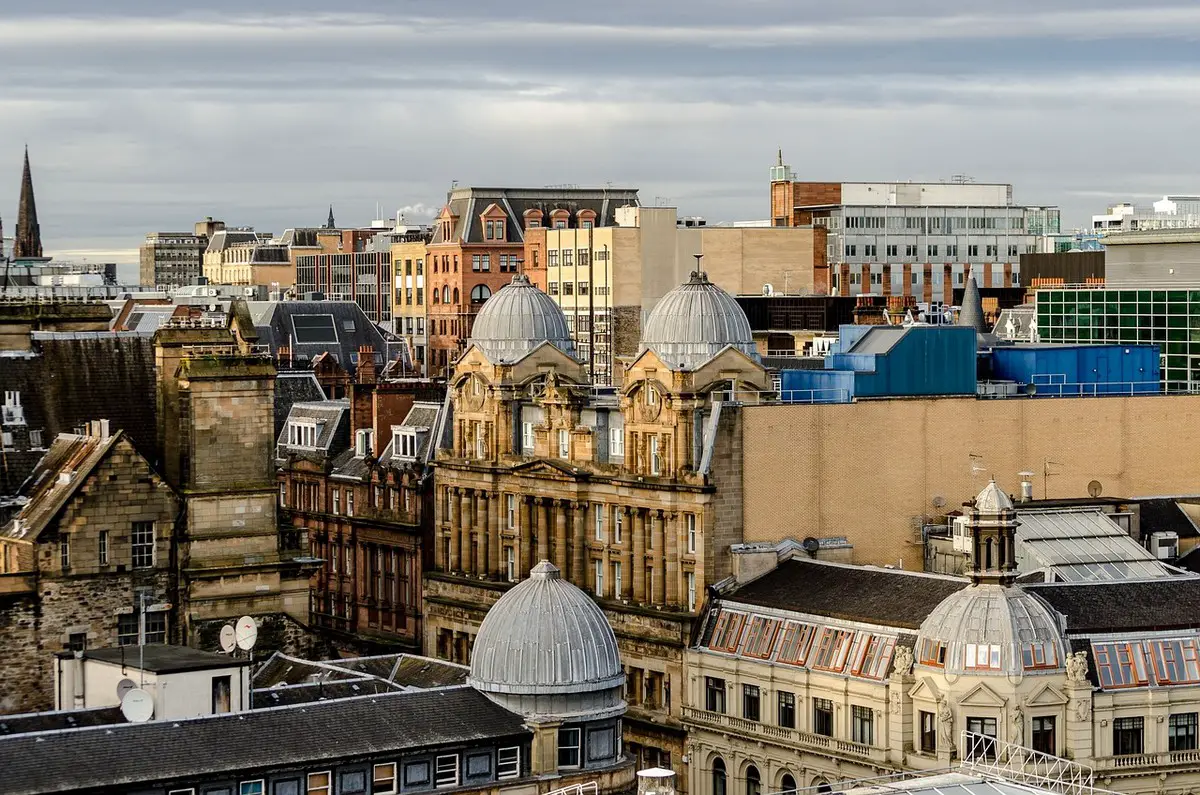Exploring the architectural evolution of Glasgow, From industrial heritage to modern urban design
Exploring the Architectural Evolution of Glasgow: From Industrial Heritage to Modern Urban Design
26 Sep 2023
Glasgow, the largest city in Scotland, is renowned for its rich architectural heritage. Over the years, the city has radically transformed from its industrial roots to a modern urban design hub. This evolution is a testament to the city’s ability to adapt and reinvent itself.
Introduction to Glasgow’s architectural evolution
Glasgow’s architectural evolution is a fascinating journey through time. The city’s architecture reflects its historical and cultural significance, showcasing a blend of styles from different eras. Glasgow’s architecture tells a story of its past and present, from grand Victorian buildings to striking Art Nouveau designs.
Glasgow’s transformation from industrial heritage to modern urban design
Glasgow’s transformation into a modern city began in the late 20th century. As industries declined, the town embraced urban regeneration and revitalization projects. Glasgow boasts an impressive skyline dominated by contemporary structures like the Clyde Auditorium and the Riverside Museum. Best dissertation writing services offer an opportunity to explore the city’s architectural and historical aspects in-depth, allowing you to delve into its evolution. These modern buildings coexist harmoniously with historically significant landmarks such as Glasgow Cathedral and the Glasgow City Chambers.
The city’s commitment to preserving its architectural heritage while embracing modern designs has made Glasgow an architectural marvel. Visitors can now explore the city’s architectural evolution, relishing in the juxtaposition of old and new that defines Glasgow’s charm.
Victorian Era Architecture
During the Victorian era, Glasgow underwent a significant architectural transformation, reflecting the industrial heritage and prosperity of the city. The architectural styles of this period are still prominent today, showcasing the city’s rich history and cultural heritage.
Characteristics of Victorian architecture in Glasgow
Victorian architecture in Glasgow is characterized by its grandeur, intricate details, and ornate features. Buildings often have decorative facades, including elaborate carvings, arches, and towers. Many structures also incorporate elements of Gothic Revival and Renaissance Revival styles, adding to the overall sense of elegance and grandeur.
Famous Victorian-era buildings in Glasgow
Glasgow boasts several iconic Victorian-era buildings that have become city landmarks. One notable example is the Glasgow City Chambers, a magnificent building featuring marble staircases, impressive sculptures, and stunning stained glass windows. Other significant structures include the Mitchell Library, St. Vincent Street Church, and the Glasgow Central Station.
Influence of Victorian architecture on the city’s development
The Victorian architecture in Glasgow beautified the city and played a significant role in its development. These buildings symbolize the city’s industrial wealth and cultural achievements. Many of these historic structures have been repurposed, housing modern businesses, cultural institutions, and residential spaces. The Victorian era’s architectural legacy continues to shape Glasgow’s modern urban design, blending the beauty of the past with the functionality of the present.
Art Nouveau and Art Deco Influences
Exploring Glasgow’s Art Nouveau landmarks
Glasgow’s architectural landscape showcases a fascinating blend of art and design movements, including the iconic Art Nouveau style. In the late 19th and early 20th centuries, the city thrived during an era of economic prosperity, reflected in its architectural achievements. Art Nouveau buildings, characterized by their intricate organic motifs and curved lines, can be found throughout Glasgow.
One of the most famous examples is the Glasgow School of Art, designed by renowned architect Charles Rennie Mackintosh. Its distinctive style and attention to detail have made it a must-visit landmark for art enthusiasts and architecture lovers.
Art Deco architecture in Glasgow
As the city progressed into the 20th century, a new architectural style emerged: Art Deco. This style embraced geometric patterns, sleek lines, and a sense of modernity. Glasgow boasts several notable Art Deco buildings, such as the Beresford Hotel and the Daily Express Building. Glasgow’s architects created a unique and vibrant cityscape by incorporating these innovative designs.
Impact of Art Nouveau and Art Deco styles on the city’s architectural landscape.
The influence of Art Nouveau and Art Deco can still be seen in Glasgow today. These architectural styles have helped shape the city’s identity and contribute to its rich cultural heritage.
The fusion of these movements with Glasgow’s industrial history has created a unique blend of old and new, making it a captivating destination for those interested in exploring the evolution of architectural design. From the organic elegance of Art Nouveau to the sleek modernity of Art Deco, Glasgow’s architectural heritage is a testament to the city’s vibrant and ever-evolving character.
Glasgow School of Art and Charles Rennie Mackintosh
The significance of the Glasgow School of Art
Glasgow has long been known as a hub for art and design, and the Glasgow School of Art holds a prominent place in the city’s architectural evolution. Established in 1845, the School of Art has played a vital role in shaping the artistic community of Glasgow and beyond.
Students and faculty have produced groundbreaking works in various disciplines, including architecture, painting, and design, earning the school international recognition.
The architectural genius of Charles Rennie Mackintosh
One figure who stands out in the Glasgow School of Art’s history is Charles Rennie Mackintosh. Mackintosh was a Scottish architect and designer who became synonymous with the Glasgow Style, a distinct artistic movement in the late 19th and early 20th centuries. His innovative approach to design, characterized by a harmonious blend of traditional and modern elements, revolutionized the field and continues to inspire architects and artists today.
Mackintosh’s most notable architectural masterpiece is the Glasgow School of Art building itself. Completed in 1909, the building showcases his visionary style with its intricate detailing, use of natural light, and innovative spatial arrangements. Sadly, the building suffered devastating fires in 2014 and 2018, but restoration efforts are underway to preserve and revive Mackintosh’s architectural legacy.
As Glasgow continues to evolve as a vibrant modern city, its architectural heritage, exemplified by the Glasgow School of Art and Charles Rennie Mackintosh, remains an integral part of its cultural identity.
Contemporary Architecture and Urban Design
Contemporary architectural trends in Glasgow
Glasgow, often called the “Dear Green Place,” has seen a fascinating evolution in its architectural landscape over the years. From its industrial heritage to its modern urban design, the city offers a blend of old and new that captivates locals and tourists alike.
Glasgow has become a hub for contemporary architecture in recent years, with several notable projects redefining the city’s skyline. One prime example is the Riverside Museum, designed by the renowned architect Zaha Hadid. Its striking design features a flowing, wave-like structure that elegantly showcases the city’s transport heritage.
Another significant development in Glasgow’s architectural scene is the SSE Hydro, a multi-purpose entertainment venue known for its distinctive domed shape. Designed by Foster + Partners, this iconic structure has become a city symbol and hosts various events, from concerts to sporting competitions.
The city’s urban design has also transformed, rejuvenating areas such as the Merchant City and the West End. These neighborhoods now feature a mix of historic buildings and modern developments, creating a vibrant and diverse atmosphere.
Glasgow’s architectural evolution highlights the city’s commitment to blending its rich industrial heritage with contemporary design concepts. The result is a cityscape that combines the old and new, making Glasgow a must-visit destination for architecture enthusiasts.
Exploring the Architectural Evolution of Glasgow – Conclusion
In conclusion, Glasgow’s architectural evolution reflects its remarkable transformation from an industrial city to a modern urban center. The city’s rich history is evident in its diverse architectural styles, from Victorian and Edwardian buildings to iconic modern structures.
Glasgow’s architectural heritage is a testament to its industrial past, with grand buildings such as the Glasgow City Chambers and Tennent’s Wellpark Brewery showcasing its proud industrial history.
However, the city has also embraced modern design, developing innovative structures like the Riverside Museum and the SSE Hydro. These contemporary buildings symbolize Glasgow’s transition into a vibrant and progressive city.
Glasgow’s architectural evolution tells a fascinating story of transformation, blending the old with the new and embracing tradition and innovation. Exploring the city’s architectural landmarks is a captivating journey that offers insight into Glasgow’s past, present, and future.
Summary of Glasgow’s architectural evolution
- Glasgow’s architectural evolution reflects its transition from an industrial city to a modern urban center.
- The city boasts diverse styles, including Victorian, Edwardian, and modern designs.
- Historic buildings like the Glasgow City Chambers and Tennent’s Wellpark Brewery represent the city’s industrial heritage.
- Glasgow has also embraced modern design with structures like the Riverside Museum and SSE Hydro.
- The architectural journey of Glasgow tells a captivating story of transformation, blending tradition and innovation.
Comments on the Exploring the Architectural Evolution of Glasgow: From Industrial Heritage to Modern Urban Design article welcome
Glasgow Architecture
Major Strathclyde Building Designs – selection:
Historic Glasgow : best Glasgow architecture of the past
Comments / photos for the Exploring the Architectural Evolution of Glasgow: From Industrial Heritage to Modern Urban Design page welcome




